Chapter 2_Number system (EEEg4302).pdf
- 1. Digital Logic Design (EEEg4302) Chapter 2 : Number System AASTU Department of Electrical and Computer Engineering 1 Milkias H.
- 2. Outline Chapter 2 : Number System • Decimal Numbers • Binary Numbers • Decimal to Binary Conversion and vice versa • 1’s and 2’s compliment of binary number • Signed Number • Hexadecimal number • Octal number • Binary Coded Decimal (BCD) Number 2
- 3. Decimal Numbers • In the decimal number system each of the ten digits 0 through 9 represents a certain quantity. • The base(radix) of decimal numbers is 10. The position of each digit in a weight number system is assigned a weight based on the base of the system. • The column weights of decimal numbers are powers of ten that increase from right to left beginning with … … 102 101 100 • For fractional decimal numbers, the column weights are negative powers of ten that decrease from left to right. 10−1 10−2 10−3 …… • Decimal numbers can be expressed as the sum of the products of each digit times the column values for that digit. Example: 123 → 1*102 + 2*101 + 3*100 45.367 → 4*101 + 5*100 + 3*10−1 + 6*10−2 + 7*10−3 3
- 4. Binary Numbers • The binary number system is another way to represent quantities. • It have two digits: 0 and 1. so it is base 2 system. • The position of a 1 and 0 in a binary number indicates weight. • The weight of a binary number is based on powers of two. 24 23 22 21 20 • For fractional binary number the weight are negative power of two that decrease from left two right. 2−12−22−32−42−5 4
- 5. Binary Numbers Examples: 1010 → 1*23 + 0*22 + 1*21 + 1*2024 10.01 → 1*21 + 0*20 + 0*2−1 + 1*2−2 Binary Number Operation: Add & Sub: 1 + 1 = 10 1 – 1 = 0 0 + 0 = 0 0 – 0 = 0 1 + 0 = 1 1 – 0 = 1 5 Mul & Div: 1 * 1 = 1 1 / 1 = 1 0 * X = 0
- 6. Decimal to Binary Numbers • For Non Fractional Number Repeated Division by two methods. (160)10 = (10100000)2 • For Fractional Number Repeated multiplication by two. (0.188)10 = (0.00110)2 → for five significant digits 6
- 7. Binary to Decimal Conversion • The decimal value of any binary number can be found by adding the weights of all bits that are 1 and discarding the weight of all bits that are 0. • We multiply each binary digits by its weighted position and add each of the weighted value together. 7
- 8. Binary to Decimal Conversion • Any numbering system can be summarized by the following relationship: 8
- 9. Binary to Decimal Conversion • Example 9 (1010)2 = (10)10 (0.1011)2 = (0.6875)10
- 10. Binary to Decimal Conversion Exercise • Convert the following decimal to binary format: 65 25.4 • Convert the following binary to decimal format: 101011 1010.01 10
- 11. 1’s and 2’s Compliment of Binary Number o 1’s compliment representation: • Is just the inverse of a binary number. • To form 1’s compliment invert very bit of the number. • 1’s compliment of 1001 is 0110. o 2’s compliment representation: • Found by adding 1 to LSB of the 1’s compliment. • 2’s compliment of 1001 is 0110 + 1, which is 0111. 11
- 12. Signed Number • Digital systems, such as computer must handle both positive and negative numbers. • A signed binary number consists of both sign and magnitude information. • There are three forms in which signed numbers can be represented in binary: I. Sign-magnitude form (least used) II. 1’s complement form III. 2’s complement form (most important) • N.B: The left most bit (MSB) in all forms of a signed number is the sign bit, which tells you whether the number is positive or negative. Positive number → 0 for sign bit Negative number → 1 for sign bit 12
- 13. Signed Number I. Sign-magnitude form • When a signed binary number is represented in sign-magnitude form, the left most bit is the sign bit and the remaining bits are magnitude bits in true (uncomplemented form). • Example: using sign-magnitude form (+9) expressed as 8 bit signed binary And (-9) as • Notice that the only difference between (+9) and (-9) is the sign bit. 13 1 0 1 0 1 0 1 0 Sign bit Magnitude bits 0 0 0 0 1 0 0 1 1 0 0 0 1 0 0 1
- 14. Signed Number II. 1’s complement form • Positive numbers in 1’s complement form are represented the same way as sign-magnitude numbers. • Negative numbers are the 1’s complements of the corresponding positive numbers. • Example: using 1’s complement form (+9) expressed as 8 bit signed binary And (-9) as 14 0 0 0 0 1 0 0 1 1 1 1 1 0 1 1 0 1’s complement
- 15. Signed Number III. 2’s complement form • Positive numbers in 2’s complement form are represented the same way as sign-magnitude and 1’s complement forms. • Negative numbers are the 2’s complement of the corresponding positive numbers. • Example: using 2’s complement form (+9) expressed as 8 bit signed binary And (-9) as • An easy way to read a signed number that uses this notation is to assign the sign bit a column weight of -128 (for an 8-bit number). Then add the column weight for the 1’s. 15 0 0 0 0 1 0 0 1 1 1 1 1 0 1 1 1 2’s complement
- 16. Signed Number • Exercise: Express the decimal number (-20) as an 8 bit number in the (i) Sign-magnitude (ii) 1’s complement and (iii) 2’s complement forms. First, find 8 bit binary conversion of (+20) (i) Sign-magnitude o change the sign bit to one (ii) 1’s complement o 1’s complement of (+20) (iii) 2’s complement forms. o 2’s complement of (+20) 16 0 0 0 1 0 1 0 0 1 0 0 1 0 1 0 0 1 1 1 0 1 0 1 1 1 1 1 0 1 1 0 0
- 17. Signed Number • Why 2’s complement form is preferred for representing signed integer numbers? o Because its easier to convert back to decimal.(1’s complement requires adding 1 to summation of weight) o And there are two possible representations of zeros in 1’s complement form which are [00000000] and [11111111]. Range Of Signed Integer Numbers That Can Be Represented o The formula for finding the number of different combinations of n-bit is Total combination = 2𝑛 o For 2’s complement signed numbers, the range of values for n-bit numbers is Range = - (2𝑛−1) to +(2𝑛−1 - 1) 17
- 18. Signed Number Arithmetic Operations With Signed Numbers 1. ADDITION: • The addition of two signed numbers with negative numbers represented in signed 2’s complement form is obtained from the addition of the two numbers including their sign bits. • A carry out of the sign bit position is discarded. Example: +6 00000110 -6 11111010 +13 00001101 +13 00001101 +19 00010011 +7 00000111 : +6 00000110 -6 11111010 -13 11110011 -13 11110011 -7 11111001 -19 11101101 18 1 Discard carry 1 Discard carry addend augend sum
- 19. Signed Number Arithmetic Operations With Signed Numbers 1. ADDITION: • 0verflow condition : when two numbers are added and the number of bits to represent the sum exceeds the number of bits in the two numbers. • An over flow results as indicated by an incorrect sign bit. • Occurs only when both numbers are positive or when both numbers are negative. 19
- 20. Signed Number Arithmetic Operations With Signed Numbers 2. SUBTRACTION: • Subtraction is addition with the sign of the subtrahend changed. As demonstrated by the following relationship (±A) - (+B) = (±A) + (-B) (±A) - (-B) = (±A) + (+B) • Take the 2’s complement of the subtrahend (including the sign bit) and add it to the minuend (including the sign bit). A carry out of the sign bit position is discard. Example : subtracting +6 (the subtrahend) from +9(minuend) is equivalent to adding (-6) to (+9). (9) - (6) = 3 = (9) + (-6) 20 difference minuend subtrahend -6 11111010 +9 00001001 +3 00000011 1 Discard carry
- 21. Signed Number Arithmetic Operations With Signed Numbers 3. MULTIPLICATION: • The multiplication operation in most computers is accomplished using addition. • Direct addition and partial products are two basic methods for performing multiplication using addition. • In direct addition method, you add the multiplicand a number of times equal to the multiplier. • The partial product method is the more common one. The multiplicand is multiplied by each multiplier digit beginning with the least significant digit. Example 1. multiply the signed binary numbers 01001101 (multiplicand) and 00000100 (multiplier) using direct addition method. Solution since both numbers are positive, they are in true form and the product will positive . the decimal value of the multiplier is 4, so the multiplicand is added to it self four time as follows 01001101 1st time +01001101 2nd time 10011010 partial sum +01001101 3rd time 11100111 partial sum +01001101 4th time 100110100 product 21
- 22. Signed Number Arithmetic Operations With Signed Numbers 3. MULTIPLICATION: Example 2. Multiply the signed binary number 01010011 (multiplicand) and 11000101 (multiplayer) using partial product method. Step 1. The sign bits are different, the product will be negative (1). Step 2. Take the 2’s complement of the multiplier to put it in true form. 11000101 00111011 22 Step 3. the multiplication proceed as follows. Notice that only the magnitude bits are used in this step. Step 4. since the sign of product is 1 as determined in step 1, take the 2’s compliment of the product. 1001100100001 0110011011111 Attach the sign bit 1 0110011011111
- 23. Signed Number Arithmetic Operations With Signed Numbers 4. DIVISION: • The division operation computers is accomplished using subtraction. • Since subtraction is done with an adder, division can be accomplished with an adder. 𝑑𝑖𝑣𝑖𝑑𝑒𝑛𝑑 𝑑𝑖𝑣𝑖𝑠𝑜𝑟 = 𝑞𝑢𝑜𝑡𝑖𝑒𝑛𝑡 Example Divide 01100100 by 00011001 Solution. Step 1, the sign of both numbers are positive . Step 2. subtract the divisor from dividend using 2’s compliment addition . 01100100 +11100111 01001011 Add 1 to quotient( quotient is initially zero): 00000000 + 00000001 = 00000001 23 dividend 2’s compliment of divisor Positive first partial remainder
- 24. Signed Number Arithmetic Operations With Signed Numbers 4. DIVISION: Step 3. subtract the divisor from the 1st partial remainder using 2’s compliment addition . 01001011 +11100111 00110010 Add 1 to quotient : 00000010 Step 4. subtract the divisor from the 2nd partial remainder using 2’s complement addition 00110010 +11100111 00011001 Add 1 to quotient : 00000011 Step 5. subtract the divisor from 3rd partial remainder using 2’s complement addition 24 1st partial remainders 2’s complement of divisor Positive 2nd partial remainder 2nd partial remainders 2’s complement of divisor Positive 3rd partial remainder
- 25. Signed Number Arithmetic Operations With Signed Numbers 4. DIVISION: Step 5. subtract the divisor from 3rd partial remainder using 2’s complement addition 00011001 +11100111 00000000 Add 1 to quotient : 00000100 (final quotient). 25 3rd partial remainder 2’s complement of divisor zero remainder
- 26. Hexadecimal Number • The hexadecimal number system has sixteen characters; Consists of digits 0-9 and letters A-F. • It is used primarily as a compact way of displaying or writing binary numbers. • Is widely used in computer and microprocessor applications. • Has a base of sixteen. • Large binary number can easily be converted to hexadecimal by grouping bits 4 at a time and writing the equivalent hexadecimal character. 26
- 27. Hexadecimal Number 27 Counting in hexadecimal • Once you get to F, simply start over with other column and continue. • With two hexadecimal digits, you can count up to (FF) which is 255 in decimal. • The maximum three digit is (FFF) or decimal 4095.
- 28. Hexadecimal Number Binary to Hexadecimal conversion • Converting a binary number to hexadecimal is straight forward procedure. Simply break the binary number in to 4 bit group with the equivalent hexadecimal symbol. • Example: convert the following binary number to hexadecimal: a) 1100101001010111 = CA5716 b) 1010000111100011 = A1E316 28
- 29. Hexadecimal Number Hexadecimal to Binary conversion • To convert from hexadecimal number to a binary number reverse the process and replace each hexadecimal symbol with the appropriate four bits. • Example: Determine the binary number for the following hexadecimal number: (a) 10A416 0001000010100100 (b) AF6C16 1010111101101100 29
- 30. Hexadecimal Number Hexadecimal to Decimal conversion • To find the decimal equivalent of hexadecimal number is first convert the hexadecimal number to binary and then convert from binary to decimal • Example: 2D 00101101 00101101 20 + 22 + 23 + 25 =4510 • Another way to convert a hexadecimal number to its decimal equivalent is to multiply the decimal value of each hexadecimal digit by its weight and then take the sum of these products. • The weight structure • Example 2D = (2x16) + (Dx1) = 32+ 13 =4510 30 163 162 161 160 4096 256 16 1
- 31. Hexadecimal Number Decimal to Hexadecimal conversion • Repeated division of a decimal number by 16 will produce the equivalent hexadecimal number, formed by remainders of the divisions. • The first remainder produce is least significant digit (LSD). • Note that when a quotient has a fraction part, the fraction part is multiplied by the divisor to get the remainder. • Example : convert the decimal number 650 to hexadecimal by repeated division by 16. 31
- 32. Octal Number • Like hexadecimal number system the octal number system provides a convenient way to express binary numbers and codes. • However it is used less frequently than hexadecimal in conjunction with computers and microprocessors to express binary quantities for input and output purposes. • The octal number system is composed of eight digits, which are; 0 1 2 3 4 5 6 7 32
- 33. Octal Number Octal to Decimal conversion • Octal is also a weight number system. The column weights are powers of 8, which increase from right to left. • Example: Express (3702)8 in decimal. 3 7 0 2 83 82 81 80 512 64 8 1 3(512) + 7(64) + 0(8) + 2(1) = (1986)10 33
- 34. Octal Number Decimal to Octal Conversion • A method of converting a decimal number to an octal number is the repeated division-by-8 methods. • Each successive division by 8 yield a remainder that become a digit in the equivalent octal number . • The first remainder generated is the least significant digit (LSD). • Example: convert decimal number (359)10 to octal 34
- 35. Octal Number Binary to Octal Conversion • Binary number can easily be converted to octal by grouping bits 3 at a time and writing the equivalent octal character for each group. • Example: Express (100110010010)2 in octal. 100 110 010 010 4 6 2 2 = (4622)8 35
- 36. Octal Number Octal to Binary Conversion • Because each octal digit can be represented by a 3-bit binary number, it is very easy to convert from octal to binary. • Each octal digit is represented by three bits. • Example: Convert (613)8 in binary. 6 1 3 110 001 011 = (110001011)2 36
- 37. Binary Coded Decimal - BCD • Binary coded decimal is a way to express each of the decimal digits with a binary code. • There are 10 groups in the BCD system. • BCD is a weighted code that is commonly used in digital systems when it is necessary to show decimal numbers such as in clock displays. • BCD represents each decimal digit with a 4-bit code. • Notice that the codes 1010 through 1111 are not used in BCD. • For 4 bit BCD number, the column weights are 8 4 2 1 (23222120). • The ease of conversion between 8421 code numbers and familiar decimal numbers is the main advantage of the code. • To express any decimal number in BCD, simply replace each decimal digit with the appropriate 4 bit code. 37
- 38. Binary Coded Decimal - BCD 38
- 39. Binary Coded Decimal - BCD Example : convert decimal 170 to BCD 1 7 0 0001 0111 0000 To determine a decimal number from a BCD number, start at the right most bit and break the code in to groups of four bits. Then write the decimal digit represented by each 4 bit group. Example : convert the BCD number 001101010001 to decimal 0011 0101 0001 3 5 1 (351)10 39
- 40. Assignment 1: • Read and prepare a short note and presentation on Digital codes (Gray code and ASCII) [text book: page 87- ] DUE DATE : April 28, 2021 40
- 41. Last slide 41


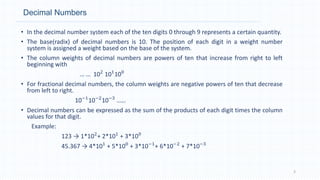








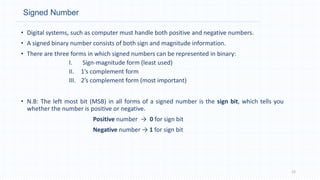


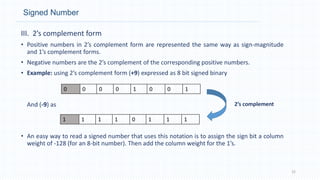
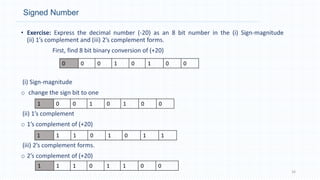
![Signed Number
• Why 2’s complement form is preferred for representing signed integer numbers?
o Because its easier to convert back to decimal.(1’s complement requires adding 1 to summation
of weight)
o And there are two possible representations of zeros in 1’s complement form which are
[00000000] and [11111111].
Range Of Signed Integer Numbers That Can Be Represented
o The formula for finding the number of different combinations of n-bit is
Total combination = 2𝑛
o For 2’s complement signed numbers, the range of values for n-bit numbers is
Range = - (2𝑛−1) to +(2𝑛−1 - 1)
17](https://image.slidesharecdn.com/chapter2numbersystemeeeg4302-230929185938-b3b0d92f/85/Chapter-2_Number-system-EEEg4302-pdf-17-320.jpg)




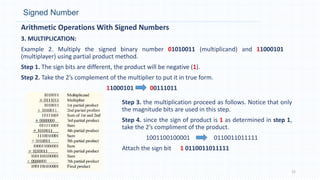

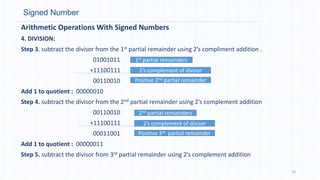















![Assignment 1:
• Read and prepare a short note and presentation on Digital
codes (Gray code and ASCII) [text book: page 87- ]
DUE DATE : April 28, 2021
40](https://image.slidesharecdn.com/chapter2numbersystemeeeg4302-230929185938-b3b0d92f/85/Chapter-2_Number-system-EEEg4302-pdf-40-320.jpg)
